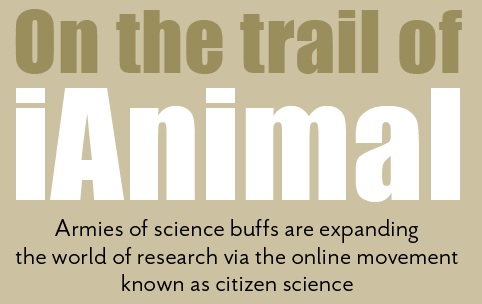ONCE OR TWICE A MONTH, Peter Callen, Mitch Johnson and friends go for a hike
in the nearby mountains or along the river, practicing what naturalists
and hunters have done for millennia: tracking animal sign. They look
for hoof prints, scat, and indications that animals may have stopped to
eat or lie down. They try to identify the type of animal and where it
was headed. They take notes about what they’ve seen.
There’s a difference to the enterprise of amateur naturalist nowadays,
however. Callen and friends are part of a nonprofit conservation group
working to protect wilderness. That calls for legislation, which
requires scientific data—reams of it—that in many cases does not exist
for particular areas. Years of reductions in funding and staffing have
left agencies like the Forest Service and BLM with few resources for
basic monitoring of the lands in their jurisdictions. So Callen and
other volunteers collect data themselves.
Every month of the year, the group walks one of seven parcels of land,
approximately 200 by 400 feet, and tracks which animals have come down
off the Sandia or traveled the arroyos that cross I-25. Their
Placitas-based group, Pathways: Wildlife Corridors of New Mexico, was
formed to identify and protect routes that large animals use to cross
between mountain ranges, as they need to do to survive (“Room to Roam”). Over the years, this has led to some intriguing maps that
show wildlife movement between the Sandia, Jemez, and Sangre de Cristo
ranges, across the Galisteo Basin, along corridors free of human
development.
Back in the mid- to late 2000s, the mapping was all done by
nature-lovers toting notebooks and field guides, in time-honored
fashion. Recently, however, the task has been transformed by the
phenomenon known as citizen science, a worldwide movement that uses the
power of the Internet and crowdsourcing to advance scientific research.
FROM BIOLOGY TO ASTRONOMY, genetics to climate science, amateurs are not
only observing natural phenomena, they are uploading what they notice to
websites like iNaturalist, Project BudBurst, and eBird, where it can be
accessed by researchers, students, policy-makers, anyone with an
Internet connection.
“A lot of great science has come from people who love nature,” says
Callen, who is hiking with Renee Robillard on this spring Saturday to
one of the seven transects that Pathways monitors, in Perdiz Canyon. “To
call something science just means that you record the time and place,
so it can be revisited.”
To
ensure that their observations are useful to others, Pathways
volunteers have learned to use tracking protocol developed by the group
CyberTracker, founded by a researcher working with Bushmen in Africa’s
Kalahari Desert. This free online software allows tracking information to be entered even by people who cannot read
or write, and pinpoints the location via GPS-enabled smartphones.
Pathways was fortunate to come across the program through Casey
McFarland, a CyberTracker trainer who lives in Cedar Crest and helped
set up their protocols.
Any Boy Scout will tell you there are many levels to animal tracking,
from guessing what animal’s foot made a print, to knowing its gender,
direction, speed, and likely activity. McFarland rates trackers in a
two-day test in the field, giving them a score of 3 (expert) down to
1—but even scoring 1 usually takes a couple of tries.
Trackers also have to learn how to input their data correctly, so it’s
useful to researchers. Everything is measured, recorded, photographed,
matched to GPS data, and described in a running narrative. Eventually it
all gets uploaded to iNaturalist and stored in Pathways’ own data base.
“Our
target animals are the large mammals that move between mountain
ranges—elk, mule deer, bobcat, mountain lion, black bear, and
pronghorn,” says Callen. “We also record vegetation, weather conditions,
soil aridity, and other observations.” Such information might help the
Forest Service, for example, understand the reason for dips in wildlife
populations. In many cases, the only monitoring that has been done by
wildlife agencies is from the air or through educated guesswork
(modeling).
THE TERM 'CITIZEN SCIENTIST' was coined in the 1990s to describe birdwatchers, whose obsession with note-taking was the first amateur resource tapped by scientists. Combined with the data-handling capacity of the Internet, this backyard activity has blossomed into scores of projects developed, in many cases, by scientists and research institutions themselves. (The biggest and best can be found at Zooniverse).
Among the early pioneers was the Cornell Laboratory of Ornithology, with its eBird data base launched in 2002. To date, some 90,000 birdwatchers have contributed more than 110 million observations used in research ranging from climate science to artificial intelligence.
Researchers strapped for money and staffing are among the most enthusiastic promoters of citizen science projects, which now range from the hyper-local (monitoring the microorganisms in your body) to the extraterrestrial (looking for patterns of suspicious radio signals in the galaxy). Armies of science buffs are especially valuable in the fields of climate science, astronomy, genetics, and biology.
Noticing the small and seemingly insignificant—a deer print in an arroyo in Placitas—takes on greater magnitude as part of the treasury of knowledge about the world that can only be seen and recorded by a human being in a particular place and time.
“The motivation is to save life on Earth, really,” Callen says. “It’s a way to learn what animals are here, and how to live with them. A lot of them are performing tasks we can’t do—disperse seed, pollinating—that are really valuable. We need them for life on Earth to function.
“This is small, but it’s a start.”

